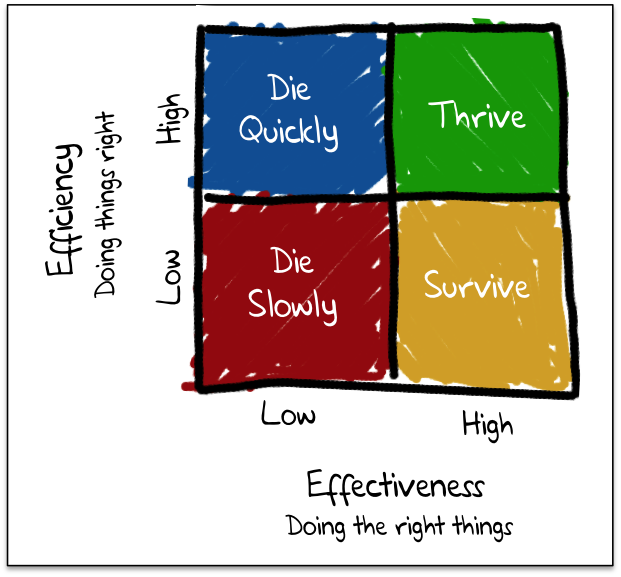Efficient vs Effective Management: Why Both Matter for Agile Teams

Efficiency is doing things right.
Peter Drucker
Effectiveness is doing the right things.
As we continue to explore words and their impact on conversations and behaviors, I would be remiss if I didn’t bring up a standard set of words that generally make me twitchy if one is emphasized more than the other — the words are Efficient and Effective. Let’s first look at the definitions of both:
effective. a. Successful in producing a desired or intended result.
efficient. a. (esp. of a system or machine) Achieving maximum productivity with minimum wasted effort or expense. (of a person) Working in a well-organized and competent way.
Using Effective and Efficient
A lot of people talk about and use both these words — in fact, with some folks, these words are their Drinking Game words (every time they say it, you drink). If your role focuses more on management, then you are likely guilty of using the word “efficient” quite frequently. If your role is focused more on creating customer-centric products or engineering excellence, then you probably say “effective” throughout the day. If what you do or build is largely commoditized or well established, you may tend to focus on how efficiently things get done. If what you produce is struggling in the market (either due to a lack of support or poor sales), the word you probably discuss more often is effectiveness.
In all these cases, the context of the person or the product dictates whether our focus is on efficiency or effectiveness. This seems fairly harmless, but problems arise when we focus on one thing more than the other. If we focus too much on achieving maximum productivity, we may tend to miss key details or skip over a crucial step that ensures quality. If we focus solely on effectiveness, we may overlook over-engineering, gold plating, and potential opportunities for improvement.
How These Words Apply to Lean and Agile
I’ve read several blogs lately about having efficient daily stand-ups, retrospectives, or planning meetings, with just a few words mentioning the importance of ensuring effectiveness. Since these meetings are about creating a team and continuously improving, effectiveness should be a key part, if not the primary part, of the discussion. In these situations, you could argue that efficiency would help drive effectiveness. For example, adhering to the 15-minute rule during stand-ups is intended to establish a time boundary that allows team members to ensure the effectiveness of their message.

Agile and Lean principles incorporate elements of both effectiveness (focusing on delivering value) and efficiency (minimizing waste). If you are an efficiency junky, don’t forget effectiveness. And if you tend to be an effectiveness aficionado, don’t forget that in today’s market landscape — things have to be done efficiently. Both of these words should be used together, and when we have a discussion about doing something better, we should understand how the improvement impacts effectiveness and efficiency. I quoted Peter Drucker at the beginning of this post, and it’s appropriate since his writings, specifically his book The Effective Executive, have long shaped this Effective vs. Efficient model and thinking. The model shows that without effectiveness, efficiency doesn’t matter. That being said, the time window for effectiveness has become smaller due to competition and more demanding consumers, meaning, in his model, you may not survive for long.
The next time we innovate around our process, let’s ensure the conversation includes doing things effectively while keeping efficiency in mind.



Responses